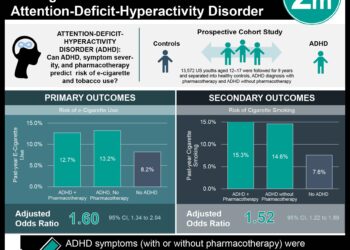Youth exposure to e-cigarette advertisements increasing
Image: PD
1. Electronic cigarette (e-cigarette) television advertising increased significantly from 2011 to 2013, with youth (ages 12-17) exposure increasing by 256% and young adult (ages 18-24) exposure increasing by 321%.
2. The large majority of e-cigarette commercials were seen on cable television in the overnight hours (from 1 to 7 AM), and one brand was responsible for most youth advertisement exposure.
Evidence Rating Level: 4 (Below Average)
Study Rundown: The sales of electronic cigarettes (e-cigarettes) have increased dramatically over the past few years and eventually reached $1 billion in annual sales in August of 2013. It is not yet fully understood how e-cigarettes affect health, but studies have suggested that nicotine exposure in youth may adversely affect brain development. Researchers of the current study sought to evaluate the extent to which youth and young adults are exposed to e-cigarette advertisements on television. Advertisements for e-cigarettes have climbed sharply, with youth and young adult exposure to advertisements increasing by 256% and 321%, respectively. Cable television accounted for the large majority of youth exposure, with advertisements on AMC reaching more youth audiences than any other television station. Results of this study are limited to television advertising (no data for online, radio, and print) and by the data collection method, which used “target rating points” as estimates of advertisement exposure. These findings may aid physicians in counseling parents and youth about reducing television exposure time and the potential harms of using e-cigarettes as substitutes for traditional cigarettes.
Click to read the study published today in Pediatrics
Relevant Reading: Electronic nicotine delivery system (electronic cigarette) awareness, use, reactions and beliefs: systematic review
In-Depth (cross-sectional study): Advertisement data from January 2011 to September 2013 was obtained from the Nielsen Company. Nielsen compiled data by means of weekly monitoring of US households, creating the ability to estimate exposure to specific advertisements by demographics. Target rating points (TRPs), the standard unit of measurement for potential television exposure, were calculated for each demographic age range. From October 2012 to September 2013, 50% of youth saw, on average, 21 e-cigarette commercials, and 50% of young adults were exposed to an average of 35 e-cigarette advertisements. Cable television accounted for 75.5% of youth e-cigarette exposure over the study period. AMC aired the most e-cigarette commercials, reaching 8.0% of youth audiences. Country Music Television was second at 6.1%, followed by Comedy Central at 5.9%. Exposure was driven mainly by one major e-cigarette brand, which accounted for 81.7% of all TRPs in the youth demographic. The majority (52.9%) of e-cigarette brand advertisements seen by youth were in the overnight hours from 1 to 7 AM.
More from this author: Decreased sleep in childhood linked with later central adiposity, Food advergames linked to increased caloric intake in children, Potential association between toddler behavior and infant media exposure, ADHD stimulant treatment associated with changes in BMI trajectory, Current BMI standards may be predictive of metabolic syndrome
©2012-2014 2minutemedicine.com. All rights reserved. No works may be reproduced without expressed written consent from 2minutemedicine.com. Disclaimer: We present factual information directly from peer reviewed medical journals. No post should be construed as medical advice and is not intended as such by the authors, editors, staff or by 2minutemedicine.com. PLEASE SEE A HEALTHCARE PROVIDER IN YOUR AREA IF YOU SEEK MEDICAL ADVICE OF ANY SORT.






